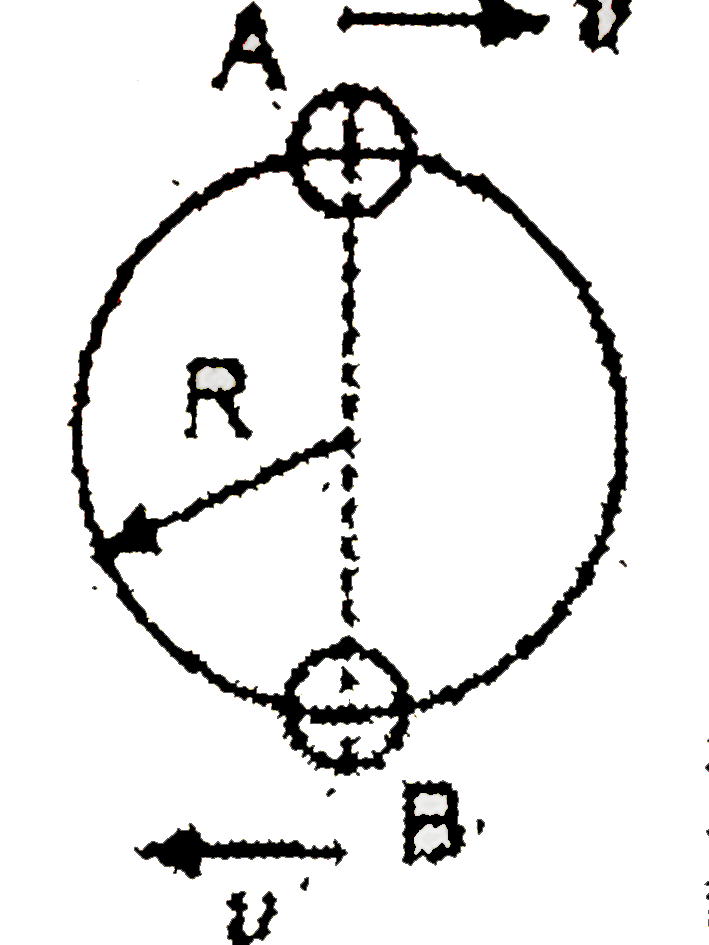Two bodies are moving with constant speed v clockwise and are initially diagonally opposite. The particle B now acheives a tangential acceleration of a m/s2. Then :

then collide after time √πRa
they collide after time √2πRa
relative velocity just before collision is √πaR
relative velocity just before collision is √πaR
The correct Answer is:b,d
Step by step video, text & image solution for Two bodies are moving with constant speed v clockwise and are initially diagonally opposite. The particle B now acheives a tangential acceleration of a m//s^(2). Then : by Physics experts to help you in doubts & scoring excellent marks in Class 11 exams.
Topper's Solved these Questions
- BOOK - ANURAG MISHRACHAPTER - FORCE ANALYSISEXERCISE - Level-349videos
FORCE ANALYSIS
- BOOK - ANURAG MISHRACHAPTER - FORCE ANALYSISEXERCISE - Matching type13videos
FORCE ANALYSIS
- BOOK - ANURAG MISHRACHAPTER - FORCE ANALYSISEXERCISE - level 1103videos
FORCE ANALYSIS
- BOOK - ANURAG MISHRACHAPTER - DESCRIPTION OF MOTIONEXERCISE - Level-334videos
DESCRIPTION OF MOTION
- BOOK - ANURAG MISHRACHAPTER - IMPULSE AND MOMENTUMEXERCISE - matching3videos
IMPULSE AND MOMENTUM
Similar Questions
Three particles are located at the corners of an equilateral triangle of side a=√3m. The particles start moving with a constant speed v=2ms such that the particle initially at A always heads towards the particle initially at B. and the particle at B heads for the particle at C and the particle at C heads for the particle-at A. The magnitude of initial acceleration (in ms2 ) of the particle at ⋅C is
View SolutionTwo particles are moving with constant speed v such that they are always at a constant distance d apart and their velocities are always equal and opposite. After what time will they return to their initial positions ?
View Solution
Knowledge Check
- Question 1 - Select One
If a body is moving with constant speed, then its acceleration
AMust be zeroBMay be variableCMay be uniformDBoth (2) & (3) - Question 2 - Select One
A particle moves with constant speed v along a circular path of radius r and completes the circle in time T. The acceleration of the particle is
A2πv/TB2πr/TC2πr2/TD2πv2/T - Question 3 - Select One
Two particles P and Q are moving on circle. At a certain instant of time both the particles and diametrically opposite and P has tangential acceleration 8m/s2 and centripetal acceleration 5m/s2 whereas Q has only e centripetal acceleration of1m/s2. At that instant acceleration (inm/s2) of P with respect to Q is
A14B√80C10D12
Two particles AandB move on a circle Initially, particles AandB are diagonally opposite to each other. Particle A moves with angular velocity πrads−1 and angular acceleration π/2rads−2 and particle B moves with constant angular velocity 2πrads−2. Find the time after which both the particlsd AnadB will collide.
View SolutionIF a body moves with constant speed along a curved path,its tangential acceleration is
View SolutionA body is revolving with a uniform speed v in a circle of radiusr . The tangential acceleration is
View SolutionA particle starts moving with a constant angular acceleration in a circular path. The time at which the magnitudes of tangential and radial acceleration are equal is
View SolutionTwo particles A and B separated by a distance 2R are moving counter clockwise along the same circular path of radius R each with uniform speed v. At time t=0, A is given a tangential acceleration of magnitude a=32v225πR in the same direction of initial velocity
View Solution

